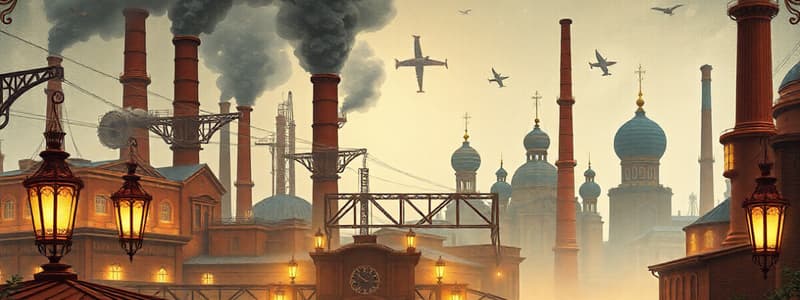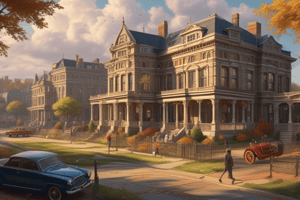Podcast
Questions and Answers
What percentage of Europe's population emigrated between 1815 and 1939?
What percentage of Europe's population emigrated between 1815 and 1939?
20%
Name two continents that received large numbers of European emigrants.
Name two continents that received large numbers of European emigrants.
The Americas and Australia
What are two reasons people emigrated from Europe?
What are two reasons people emigrated from Europe?
Poverty and displacement of farming
What are two factors that pulled people to emigrate from Europe?
What are two factors that pulled people to emigrate from Europe?
Approximately how many people returned to Europe after emigrating?
Approximately how many people returned to Europe after emigrating?
What groups did Populists in the 1890s in the US oppose?
What groups did Populists in the 1890s in the US oppose?
What type of government did Russia have during its industrialization?
What type of government did Russia have during its industrialization?
Who controlled the government in Russia?
Who controlled the government in Russia?
What was the primary motivation for freeing the Russian serfs in 1861?
What was the primary motivation for freeing the Russian serfs in 1861?
What was the status of Russian industrial output by 1900?
What was the status of Russian industrial output by 1900?
Besides Britain, what other areas globally industrialized by the late 19th century?
Besides Britain, what other areas globally industrialized by the late 19th century?
Name two social classes that declined because of industrialization.
Name two social classes that declined because of industrialization.
What sector did German industrialization focus on initially?
What sector did German industrialization focus on initially?
Where did industrialization begin in the United States?
Where did industrialization begin in the United States?
What percentage of manufactured goods was the United States producing by 1914?
What percentage of manufactured goods was the United States producing by 1914?
What did the U.S. government provide that supported industrial growth?
What did the U.S. government provide that supported industrial growth?
Which two countries are specifically compared in the text regarding the differences of their industrialization?
Which two countries are specifically compared in the text regarding the differences of their industrialization?
What social system existed in Russia before their revolution that was a major difference from the United States industrialization?
What social system existed in Russia before their revolution that was a major difference from the United States industrialization?
In 1900, where were manufacturing industries primarily concentrated in the United States?
In 1900, where were manufacturing industries primarily concentrated in the United States?
What geographic area received the largest percentage of European immigrants during the Industrial Age?
What geographic area received the largest percentage of European immigrants during the Industrial Age?
What mass production techniques did the United States pioneer?
What mass production techniques did the United States pioneer?
How was the experience of immigrants to the US described?
How was the experience of immigrants to the US described?
Who became a cultural hero for pioneering the mass-produced automobile?
Who became a cultural hero for pioneering the mass-produced automobile?
What type of social divisions grew in the U.S. during industrialization?
What type of social divisions grew in the U.S. during industrialization?
What significant change resulted from the large Russian and Ukrainian migration to Siberia?
What significant change resulted from the large Russian and Ukrainian migration to Siberia?
What transportation infrastructure played a key role in facilitating migration to Siberia?
What transportation infrastructure played a key role in facilitating migration to Siberia?
What was a typical working condition at Carnegie's Homestead steel plant?
What was a typical working condition at Carnegie's Homestead steel plant?
Besides economic opportunity, what other factors influenced European migration in the Industrial Age?
Besides economic opportunity, what other factors influenced European migration in the Industrial Age?
What type of living conditions did many immigrants experience, particularly in cities like Manhattan?
What type of living conditions did many immigrants experience, particularly in cities like Manhattan?
What was one main factor that led to the rise of labor protests and unions?
What was one main factor that led to the rise of labor protests and unions?
What generally failed to gain significant traction in the United States, despite social inequalities?
What generally failed to gain significant traction in the United States, despite social inequalities?
Flashcards
Industrial Revolution
Industrial Revolution
A period of significant technological advancements, particularly in manufacturing and production methods, that began in Great Britain in the late 18th century and spread globally.
Urbanization
Urbanization
The movement of people from rural areas to urban centers, driven by factors like job opportunities and improved living standards.
Emigration
Emigration
The process of people leaving their home countries to settle in new lands, often driven by economic hardship in their home country and opportunities abroad.
Push factors
Push factors
Signup and view all the flashcards
Pull factors
Pull factors
Signup and view all the flashcards
Global Industrialization
Global Industrialization
Signup and view all the flashcards
Outcomes of Industrialization
Outcomes of Industrialization
Signup and view all the flashcards
American Industrialization
American Industrialization
Signup and view all the flashcards
Factors Contributing to U.S. Industrialization
Factors Contributing to U.S. Industrialization
Signup and view all the flashcards
U.S. Advantage in Industrialization
U.S. Advantage in Industrialization
Signup and view all the flashcards
Government Support for U.S. Industrialization
Government Support for U.S. Industrialization
Signup and view all the flashcards
Russian Industrialization Differences
Russian Industrialization Differences
Signup and view all the flashcards
Mass Production
Mass Production
Signup and view all the flashcards
Marxist Socialism
Marxist Socialism
Signup and view all the flashcards
Strike
Strike
Signup and view all the flashcards
Labor Union Movement
Labor Union Movement
Signup and view all the flashcards
1877 Railroad Strike
1877 Railroad Strike
Signup and view all the flashcards
Social Darwinism
Social Darwinism
Signup and view all the flashcards
Social Division
Social Division
Signup and view all the flashcards
Absolute Monarchy
Absolute Monarchy
Signup and view all the flashcards
Serfdom
Serfdom
Signup and view all the flashcards
State-led Industrialization
State-led Industrialization
Signup and view all the flashcards
Industrialization
Industrialization
Signup and view all the flashcards
Social Gap
Social Gap
Signup and view all the flashcards
Global Migration in the Industrial Age
Global Migration in the Industrial Age
Signup and view all the flashcards
Factors Driving European Migration
Factors Driving European Migration
Signup and view all the flashcards
European Migration to Latin America
European Migration to Latin America
Signup and view all the flashcards
European Migration to the US
European Migration to the US
Signup and view all the flashcards
Siberian Migration
Siberian Migration
Signup and view all the flashcards
Study Notes
Variations on a Theme: Industrialization in the United States and Russia
- Industrial Revolution not confined to Britain, spread to continental Western Europe, Russia, and Japan
- Industrialization outcomes were similar, but technology and sources of energy varied broadly
- New technologies and industrialization led to urbanization
- Artisans and factory workers declined as a social class, while middle class grew
- Working-class women generally did not work alongside male counterparts
- Women had difficulty joining unions, taking jobs
- Nationalism, class conflict, various social issues developed in different societies
- Industrialization in Russia was highly focused on coal prior to textiles
- German industrialization concentrated in large companies
- Industrialization in the US relied on natural resources and its large size
- The US avoided the social conflicts that often plagued industrializing countries
- Investment was largely from American entrepreneurs
Europeans in Motion
- Industrial Revolution prompted massive migration
- Millions of Europeans moved to the Americas, Australia, New Zealand, South Africa, and parts of Asia.
- Land availability and cheap travel played significant roles.
- 7 million people returned to Europe by the end of the 19th century.
Studying That Suits You
Use AI to generate personalized quizzes and flashcards to suit your learning preferences.




